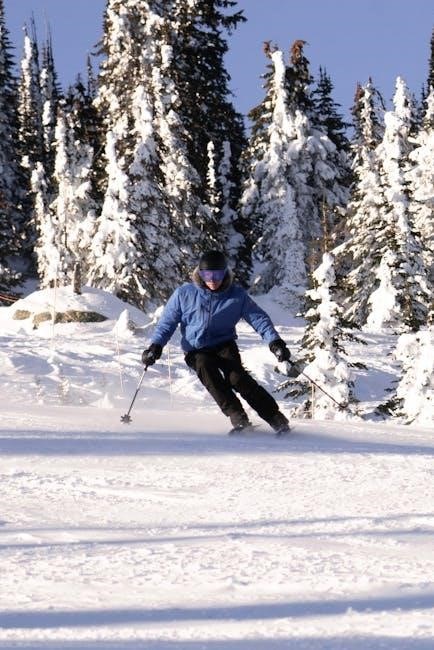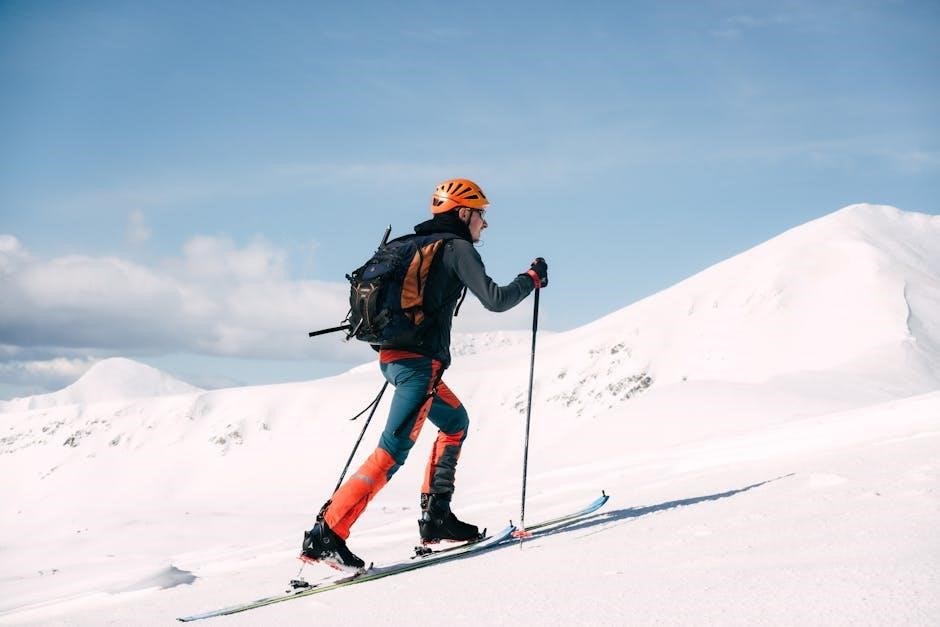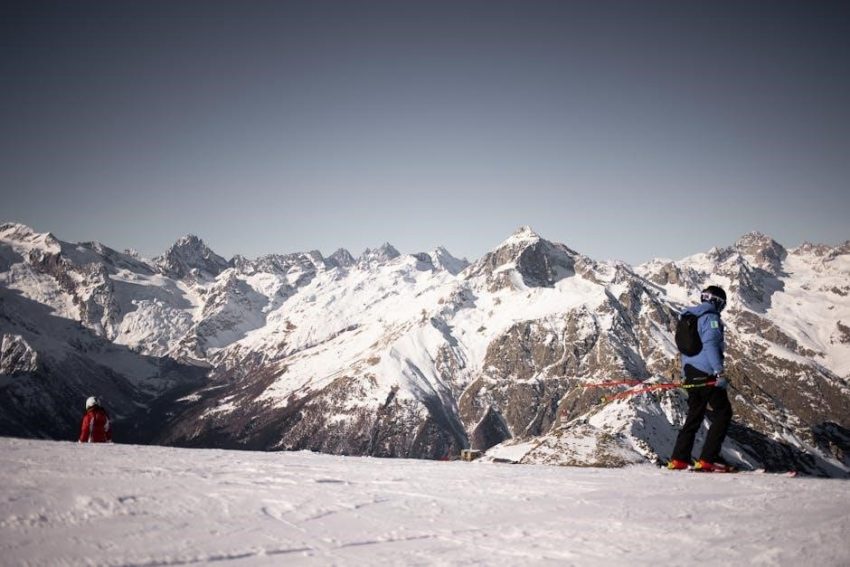Choosing the right ski pole length is crucial for optimal performance and comfort. This guide explains how to determine the perfect fit based on height, style, and terrain, ensuring a better skiing experience.
1.1 Importance of Proper Ski Pole Length
Proper ski pole length is essential for maximizing your skiing performance and comfort. Ski poles that are too long or too short can disrupt your balance, making it harder to control your movements on the slopes. The right length ensures efficient pole planting, which is crucial for setting up turns and maintaining rhythm. Properly sized poles also reduce fatigue, as they allow you to maintain a more natural stance and avoid unnecessary strain on your arms and shoulders.
Additionally, incorrect pole length can lead to poor technique, potentially causing discomfort or even injury over time. By selecting poles that match your height, skiing style, and terrain, you can enhance your overall skiing experience. This guide will help you understand how to choose the ideal ski pole length for your needs, ensuring optimal performance and enjoyment on the mountain.
1.2 Brief Overview of Ski Pole Sizing
Ski pole sizing is a critical factor in ensuring a comfortable and effective skiing experience. Generally, the correct pole length is determined by the skier’s height, with most adults requiring poles between 120 cm and 140 cm. A common rule of thumb is that the pole should reach just below the chin when stood upright. For example, a skier measuring 170 cm (5’7″) typically uses poles around 126 cm. Skiing style and terrain also play a role, with shorter poles often preferred for freestyle skiing and longer poles for cross-country or backcountry adventures. Proper sizing ensures efficient pole planting and balanced movement. This guide provides a detailed approach to determining the ideal length, helping skiers of all levels optimize their performance and comfort on the slopes.

Factors Determining Ski Pole Length
Ski pole length is determined by skier height, body proportions, skiing style, and terrain conditions. These factors collectively influence optimal pole length for performance and comfort.
2.1 Skier’s Height and Body Proportions
A skier’s height is the most significant factor in determining ski pole length. Generally, the optimal pole length is between the skier’s chin and the top of their head when standing upright. For example, a skier measuring 5’7″ (170 cm) typically uses poles ranging from 47″ to 50″ (119 cm to 127 cm). Body proportions, such as torso length and arm span, also play a role. Taller skiers may prefer slightly longer poles for better leverage, while shorter skiers benefit from shorter poles for easier handling. Proper alignment of the elbows and forearms is crucial, ensuring comfort and efficiency. Ski boots should be worn during measurements to account for added height. This foundational measurement serves as a starting point, which can be refined based on skiing style and terrain.
2.2 Skiing Style and Technique
A skier’s style and technique significantly influence the ideal pole length. For instance, aggressive skiers who prioritize speed and control may prefer shorter poles for quicker turns and better maneuverability. Conversely, skiers focused on cruising or all-mountain skiing often opt for slightly longer poles to enhance balance and stability. Technique also plays a role; skiers with a more upright stance may benefit from shorter poles, while those with a more crouched, race-inspired posture might prefer longer poles. Additionally, pole planting technique is crucial—proper pole length ensures efficient planting and rhythm in turns. The forearm test method, where the forearm is parallel to the ground when holding the pole, is a practical way to determine the optimal length. Balancing these factors ensures the poles complement the skier’s style, enhancing overall performance and comfort on the slopes.
2.3 Terrain and Snow Conditions
Terrain and snow conditions are critical factors in determining the optimal ski pole length. On groomed slopes, shorter poles may be preferable for better control and agility, especially when making quick turns. In contrast, longer poles are often beneficial for skiing in deep snow or backcountry terrain, as they provide additional leverage and help maintain balance in challenging conditions. The type of snow also plays a role; softer snow may require longer poles to prevent sinking, while harder snow can accommodate standard lengths. Adjustable poles are particularly useful in varying terrain, allowing skiers to modify their pole length based on the specific demands of the environment. Ensuring the poles match the terrain and snow conditions enhances stability, control, and overall skiing efficiency, making the experience more enjoyable and safer. Proper adjustment can make a significant difference in navigating diverse mountain landscapes effectively.

How to Measure Ski Pole Length
To measure ski pole length, stand in ski boots, hold poles upside down with the basket on the ground. Ensure your forearm is horizontal for optimal fit.
3.1 The Forearm Test Method
The Forearm Test Method is a simple way to determine proper ski pole length. Stand in your ski boots, holding the poles upside down with the baskets touching the ground. Your elbows should be slightly bent, and your forearms should be parallel to the ground. This ensures the poles are the right height for efficient skiing. If your forearms are not horizontal, adjust the length accordingly. This method is widely recommended because it provides a consistent reference point for sizing. Proper alignment ensures better control, balance, and energy efficiency while skiing. Always wear your ski boots during the test, as boot height affects posture and measurement accuracy. By following this approach, you can quickly and accurately find the ideal ski pole length for your needs.
3.2 Standing Upright with Poles
Standing upright with your ski poles is another effective way to measure the correct length. Hold the poles upside down, with the baskets touching the ground and the grips at the top. Place your hands under the baskets, keeping your elbows slightly bent. Your forearms should be parallel to the ground for the optimal fit. This method ensures the poles are proportional to your height and body alignment. Wearing your ski boots during this test is essential, as boot height affects your posture and the accuracy of the measurement. Properly fitted poles will allow you to maintain good posture and balance, reducing fatigue and improving your skiing technique. This straightforward method is widely used for its simplicity and effectiveness in determining the right ski pole length for various skiing styles and terrains.
3.4 Using a Ski Pole Size Chart
A ski pole size chart is a practical tool for determining the ideal pole length based on your height. These charts typically correlate your height with a recommended pole length, often ranging from 100cm to 135cm. For example, a skier measuring 5’8″ (173 cm) might require poles around 125cm. The charts are designed to account for average body proportions, ensuring the poles are proportional to your height and skiing style. While charts are helpful, they should be used as a starting point. Always consider your skiing technique, terrain preferences, and personal comfort. Some charts also differentiate between downhill, cross-country, and touring skis, as each discipline may require slightly different lengths. By referencing a size chart, you can quickly narrow down your options and find the most suitable poles for your needs.

How to Choose the Right Ski Poles
Choosing the right ski poles involves balancing adjustability, basket size, and material. Adjustable poles offer versatility for varying conditions, while larger baskets are better for deep snow. Prioritize materials and grip comfort for optimal performance.
4.1 Adjusting Pole Length for Different Conditions
Adjusting ski pole length based on terrain and snow conditions can significantly enhance performance. For downhill skiing, slightly shorter poles improve agility, while longer poles are better for backcountry or deep snow to maintain balance. On flat terrain, shorter poles reduce fatigue. Adjustable poles are ideal for varying conditions, allowing customization to suit the environment. When ascending, lengthening poles can aid in maintaining rhythm, while shorter lengths are preferable for descents to prevent tangling. Testing poles on different surfaces ensures the right fit, optimizing control and comfort. Proper adjustment prevents fatigue and enhances technique, making it crucial to tailor pole length to specific skiing scenarios. Always consider terrain difficulty and personal skiing style when modifying pole length for the best experience.
4.2 Fixed-Length vs. Adjustable Poles
Choosing between fixed-length and adjustable ski poles depends on your skiing needs. Fixed-length poles are durable, lightweight, and ideal for skiers who primarily ski in one type of terrain. They are less prone to mechanical issues and offer consistent performance. Adjustable poles, on the other hand, provide versatility for varying conditions. They are perfect for ski tours, backcountry adventures, or when skiing in changing snow depths. Adjustable poles allow you to customize the length for ascents, descents, or deep snow, enhancing stability and control. However, they may be heavier and require more maintenance. For casual skiers, fixed-length poles are sufficient, while serious adventurers benefit from adjustability. Consider your skiing style, terrain preferences, and frequency of use when deciding between the two options to ensure optimal performance and comfort on the slopes.
4.3 Considerations for Ski Tours and Ascents
For ski tours and ascents, choosing the right pole length is critical for efficiency and comfort. Adjustable poles are highly recommended as they allow customization for varying terrain and snow conditions. When ascending, shorter poles provide better balance and reduce fatigue, while longer poles are ideal for descents to maintain stability. A common recommendation is to opt for poles with a length of around 126 cm for ski tours, as this offers a versatile fit for both climbing and downhill segments. Additionally, consider poles with durable, lightweight materials to handle the demands of backcountry skiing. Testing poles on different surfaces and consulting a professional can also ensure the best fit for your specific needs, enhancing your overall skiing experience during tours and ascents.

Impact of Ski Pole Length on Performance
Proper ski pole length enhances balance, control, and efficiency, directly influencing skiing dynamics. Incorrect lengths can hinder technique, reduce stability, and increase fatigue, affecting overall performance on the slopes.
5.1 Balance and Control on Slopes
Proper ski pole length plays a critical role in maintaining balance and control on the slopes. When poles are correctly sized, they allow skiers to maintain an upright posture, distribute weight evenly, and make precise movements. Correctly fitted poles enable better leverage for turning and stopping, enhancing overall stability. Conversely, poles that are too long or too short can disrupt balance, making it harder to control direction and speed. Forearm testing is a reliable method to ensure proper fit, as it aligns the skier’s arms and poles for optimal performance. Improperly sized poles can lead to poor technique, fatigue, and reduced control, especially on uneven or challenging terrain. Thus, precise pole length is essential for confident and efficient skiing, ensuring a smoother and more enjoyable experience on the mountain.
5.2 Efficiency in Pole Planting Technique
The efficiency of pole planting is significantly influenced by the correct ski pole length. Properly sized poles enable skiers to maintain an optimal stance, allowing for smooth and consistent planting. When poles are too long, they can cause the elbows to be overly bent, leading to awkward movements. Conversely, poles that are too short may require skiers to hunch over, disrupting balance and rhythm. The forearm test is a reliable method to ensure the right fit, promoting efficient planting and maintaining proper skiing posture. Efficient pole planting enhances timing and propulsion, crucial for maintaining rhythm on the slopes. Additionally, appropriate pole length adapts to different skiing styles and terrains, ensuring consistent performance in various conditions. Thus, correct pole length is essential for effective and energy-efficient skiing, directly impacting the overall quality of the skiing experience.
5.3 Fatigue Reduction with Proper Fit
Properly fitted ski poles play a crucial role in reducing skier fatigue. When poles are too long or too short, they can cause unnecessary strain on the arms, shoulders, and back, leading to quicker exhaustion. Correctly sized poles allow for a more natural skiing stance, distributing weight evenly and minimizing physical effort. The forearm test method ensures that elbows are slightly bent, reducing strain during pole planting. Additionally, standing upright with poles at the correct height helps maintain proper posture, preventing muscle fatigue. Skiers who use poles tailored to their height and skiing style often report improved endurance and reduced discomfort during long days on the slopes. Proper fit not only enhances performance but also contributes to a more enjoyable and sustainable skiing experience, making it essential to prioritize accurate sizing. This ensures that skiers can maintain energy levels and enjoy their time on the mountain without unnecessary strain.

Common Mistakes in Ski Pole Selection
Common mistakes include using a one-size-fits-all approach, ignoring terrain-specific needs, and overlooking basket size. These errors can lead to poor performance and discomfort on the slopes.
6.1 Using a One-Size-Fits-All Approach
Using a one-size-fits-all approach when selecting ski poles is a common mistake that can significantly impact performance. Ski pole length is not universal, as it depends on factors like skier height, skiing style, and terrain. A pole that works for one person may be too long or too short for another, leading to poor control and technique. This mistake often stems from borrowing poles or assuming a standard size fits everyone. Proper fit ensures optimal balance, efficient pole planting, and reduced fatigue. To avoid this error, skiers should measure their pole length based on their specific needs, such as using the forearm test method or consulting a size chart. Ignoring individual requirements can result in discomfort and hinder overall skiing performance.
6.2 Ignoring Terrain-Specific Requirements
Ignoring terrain-specific requirements is another common mistake when choosing ski poles. Different skiing environments, such as powder, groomed slopes, or backcountry, demand varying pole lengths for optimal performance. For example, longer poles may be beneficial for flat or uphill terrains, while shorter poles are better for steep or technical descents. Using the same pole length across all conditions can lead to poor control, inefficient technique, and increased fatigue. Skiers often overlook how terrain affects their balance and movement, which can result in suboptimal skiing experiences. Adjusting pole length based on the specific terrain ensures better maneuverability, stability, and overall skiing efficiency. Failing to consider these factors can hinder performance and comfort on the slopes. Always tailor your pole length to the terrain for the best results.
6.3 Overlooking the Importance of Basket Size
Overlooking the importance of basket size is a frequent mistake when selecting ski poles. The basket, located at the tip of the pole, plays a crucial role in providing stability and preventing the pole from sinking into the snow. Larger baskets are ideal for deep powder or soft snow, as they offer better flotation and reduce the likelihood of the pole getting stuck. Conversely, smaller baskets are more suitable for groomed slopes or hard-packed snow, where precision and control are prioritized. Ignoring basket size can lead to poor performance, as the wrong size may cause the pole to sink too deeply or fail to provide adequate support. Always consider the type of snow conditions you’ll be skiing in when choosing your pole baskets, as this directly impacts your skiing efficiency and control. Proper basket size ensures a more enjoyable and effective skiing experience.

Additional Tips for Optimal Ski Pole Fit
Ensure optimal ski pole fit by wearing ski boots during measurements, testing poles on various surfaces, and consulting a professional for personalized advice and expert guidance.
7.1 Wearing Ski Boots During Measurement
Wearing ski boots during the measurement process ensures accuracy in determining the correct ski pole length. Ski boots affect posture and balance, which influence how poles fit and function. When measuring, stand in your boots and hold the poles upright or upside down, depending on the method. This helps replicate real skiing conditions, providing a true reflection of how the poles will perform on the slopes. Proper alignment with boots on ensures optimal ergonomics, reducing fatigue and improving control. Neglecting to wear boots may lead to incorrect sizing, affecting technique and comfort. Always prioritize this step for a precise and comfortable fit.

7.2 Testing Poles on Different Surfaces
Testing ski poles on various surfaces is essential to ensure they perform well in different conditions. Groomed slopes, powder, and icy terrain require distinct pole handling. On harder snow, shorter poles may be preferable for better control, while deeper snow might demand longer poles for stability. Experimenting on different surfaces helps identify the optimal length and basket size for each scenario. Pay attention to how the poles plant and release from the snow, as this affects rhythm and energy efficiency. Adjustable poles are particularly useful for testing across multiple surfaces. By evaluating performance on different terrains, skiers can make informed decisions about their equipment, ensuring a more comfortable and effective skiing experience. This step is crucial for adapting to varying mountain conditions and enhancing overall skiing performance.
7.3 Consulting with a Ski Professional
Consulting with a ski professional is a valuable step in ensuring the perfect fit for your ski poles. Experts can provide personalized recommendations based on your skiing style, height, and the terrain you frequent. They often have extensive knowledge of different pole designs and materials, helping you make an informed decision. Additionally, professionals can demonstrate proper techniques for using your poles effectively, enhancing your overall skiing experience. Many ski shops offer free consultations, where they can measure you and recommend the ideal pole length. Their insights can prevent common mistakes, such as choosing poles that are too long or too short. By leveraging their expertise, you can optimize your performance, reduce fatigue, and enjoy a more comfortable and efficient skiing experience. This step is particularly beneficial for those new to skiing or looking to upgrade their equipment.
Proper ski pole length is essential for performance, comfort, and control. By following this guide, you can make informed decisions to enhance your skiing experience and technique effectively.
8.1 Recap of Key Points
8.2 Final Tips for Choosing the Right Ski Poles
When selecting ski poles, prioritize proper fit and functionality. Test poles on various surfaces to ensure comfort and stability; Consider adjustable poles for versatility in different terrains. Always wear ski boots during measurements for accuracy. Pay attention to basket size, as larger baskets perform better in deep snow. Consulting a professional can provide personalized recommendations. Remember, optimal pole length enhances balance, control, and efficiency, reducing fatigue. By following these guidelines, skiers can make informed decisions, ensuring a more enjoyable and effective skiing experience. Properly fitted poles are essential for maximizing performance and comfort on the slopes.
